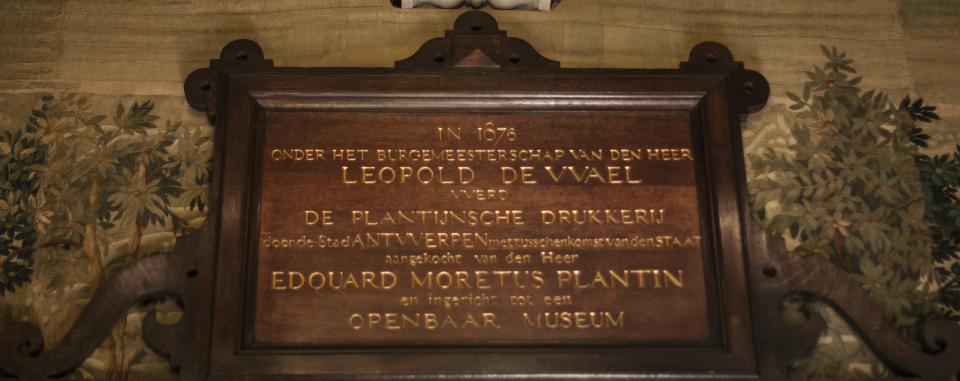Mission
Welcome to the authentic home and workshop of the Plantin-Moretus printing family. The creaking oakwood panels and planks are imbued with centuries of books, printing and entrepreneurial flair. The world’s oldest printing presses stand here, and tens of thousands of books on just about every subject of interest. This UNESCO World Heritage Site offers a unique historical experience, taking you back to Antwerp’s golden sixteenth century.
The Officina Plantiniana printing business had an eye for quality, tradition and innovation. We have inherited these values. With the same care and dynamism, we manage the extensive and unique collection in this house for future generations. We create links between the past and today’s and tomorrow’s public.
The many books and prints, letters and woodcuts bear witness to the intense activity in this centre of media and science in the age of humanism. The focus of our running of this place today is the development of expertise through research, collaboration and exchange.
Historic house, art collection, printing museum, archive, library and print cabinet: we are all these things and more. This Museum is a living entity.
Vision
This is the authentic residence of the most influential and largest printer in the Western world in the sixteenth century. In that golden age, Antwerp was a global economic and cultural player. The strength of this Museum lies in its combination of patrician mansion and printing press with the vivid stories of the people who lived here, and in its blend of art, culture and technology. It is also a printing museum with an exceptional typographical collection, a print cabinet, an old library, a family and business archive and an industrial heritage site.
What you see here is authentic. The residence and the complete printing shop of the Plantin-Moretus printing family have been preserved intact. The site has twofold recognition from UNESCO: the whole complex with its contents as a UNESCO World Heritage Site, and the archive as a ‘Memory of the World’. The Museum thus has a unique position internationally. We have ensured that this authenticity retains its value amid the many transformations that society around the Museum has undergone over the centuries. We also set this quality standard for the general running of the Museum and the different departments.
The business was a hub that accumulated and disseminated knowledge and images, in much the same way as the Internet does today. It thus served as an international meeting place for leading thinkers and scientists, a centre for media and humanism. Likewise, people go there today in search of new insights. Promoting scientific investigation into the history of the sixteenth to eighteenth centuries on the basis of the collection is an ongoing task. Through research, collaboration and the exchange of both objects and knowledge.
We readily share our expertise with our colleagues in national and international networks. We are a multi-faceted centre of expertise. Our specialist fields are pre-industrial printing with a focus on the sixteenth and seventeenth centuries, graphic work by masters from Antwerp and elsewhere from the sixteenth century to the present day, and the functioning of a historic house. We conduct research in collaboration with other partners. In this way, we ensure a continuous exchange of experience, knowledge and ideas.
The Museum is a warm and hospitable house where visitors will feel welcome. We are approachable and customer-friendly in all aspects of the running of the Museum, from the reception desk, shop and reading room to our handling of telephone calls.
The Museum is a distinctive experience. The visitor steps into a time machine for a captivating journey into the past. People learn through experience, throughout their lives, everywhere and at all times. This makes the Museum an ideal open learning environment for a broad public.
The collection has endless fascinating stories to tell that appeal to a very diverse audience. By attuning to new target groups, the Museum reinforces its social relevance in a constantly changing city and world.
The Museum feels a bond in the area around Vrijdagmarkt with its creative entrepreneurs and with the residents of the working-class Sint-Andries neighbourhood.
Attention to continuity and innovation go hand in hand. The wealth of the hidden collections is made visible by using them actively, regularly and in different ways. The Museum is developing a new approach to the presentation of the collection for today’s visitors. For the Museum itself, this is a fascinating quest for points of contact between the Museum’s essence and contemporary society.
The use of new media broadens the possibilities for high-quality work at all levels. We take full advantage of digital opportunities for access, transfer and interaction.
Dynamic interaction with the public and current trends and developments are breaking down the walls of the Museum. We consciously participate in developments around us.
We place an emphasis on sustainability, out of respect for people, the collection and the environment. This respectful attitude also applies to the internal running of the Museum, from personnel policy to building management. We are working to create an atmosphere in which every employee can do his or her work with pride, as is proper for a site with world heritage status.
This Museum makes an impression. It is authentic, unique and complete.


